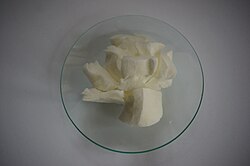Nitrate film
|
|
|||
 |
|||
| Names | |||
|---|---|---|---|
| Other names
Cellulose nitrate; Flash paper; Flash cotton; Flash string; Gun cotton; Collodion; Pyroxylin
|
|||
| Identifiers | |||
| ChemSpider |
|
||
| Properties | |||
| (C 6H 9(NO 2)O 5) n (C 6H 8(NO 2) 2O 5) n (C 6H 7(NO 2) 3O 5) n |
|||
| Appearance | Yellowish white cotton-like filaments | ||
| Melting point | 160 to 170 °C (320 to 338 °F; 433 to 443 K) (ignites) | ||
| Hazards | |||
| NFPA 704 | |||
| Flash point | 4.4 °C (39.9 °F; 277.5 K) | ||
| Lethal dose or concentration (LD, LC): | |||
|
LD50 (median dose)
|
10 mg/kg (mouse, IV) | ||
|
Except where otherwise noted, data are given for materials in their standard state (at 25 °C [77 °F], 100 kPa).
|
|||
|
|
|||
| Infobox references | |||
Nitrocellulose (also known as cellulose nitrate, flash paper, flash cotton, guncotton, and flash string) is a highly flammable compound formed by nitrating cellulose through exposure to nitric acid or another powerful nitrating agent. When used as a propellant or low-order explosive, it was originally known as guncotton.
Partially nitrated cellulose has found uses as a plastic film and in inks and wood coatings. In 1862 the first man-made plastic, nitrocellulose, (branded Parkesine) was created by Alexander Parkes from cellulose treated with nitric acid and a solvent. In 1868, American inventor John Wesley Hyatt developed a plastic material he named Celluloid, improving on Parkes' invention by plasticizing the nitrocellulose with camphor so that it could be processed into finished form and used as a photographic film. Celluloid was used by Kodak, and other suppliers, from the late 1880s as a film base in photography, X-ray films, and motion picture films, and was known as nitrate film. After numerous fires caused by unstable nitrate films, "safety film" (cellulose acetate film) started to be used from the 1930s in the case of X-ray stock and from 1948 for motion picture film.
Henri Braconnot discovered in 1832 that nitric acid, when combined with starch or wood fibers, would produce a lightweight combustible explosive material, which he named xyloïdine. A few years later in 1838, another French chemist, Théophile-Jules Pelouze (teacher of Ascanio Sobrero and Alfred Nobel), treated paper and cardboard in the same way.Jean-Baptiste Dumas obtained a similar material, which he called nitramidine. These substances were highly unstable and were not practical explosives.
...
Wikipedia



